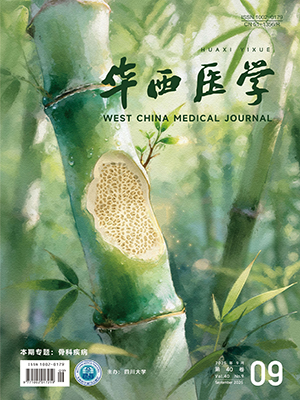| 1. |
Marchesini G, Bugianesi E, Forlani G, et al. Nonalcoholic fatty liver, steatohepatitis, and the metabolic syndrome. Hepatology, 2003, 37(4): 917-923.
|
| 2. |
Fuchs CD, Claudel T, Trauner M. Role of metabolic lipases and lipolytic metabolites in the pathogenesis of NAFLD. Trends Endocrinol Metab, 2014, 25(11): 576-585.
|
| 3. |
Fan JG, Li F, Cai XB, et al. The importance of metabolic factors for the increasing prevalence of fatty liver in Shanghai factory workers. J Gastroenterol Hepatol, 2007, 22(5): 663-668.
|
| 4. |
Fan JG, Zhu J, Li XJ, et al. Prevalence of and risk factors for fatty liver in a general population of Shanghai, China. J Hepatol, 2005, 43(3):508-514.
|
| 5. |
Liao XH, Cao X, Liu J, et al. Prevalence and features of fatty liver detected by physical examination in Guangzhou. World J Gastroenterol, 2013, 19(32): 5334-5339.
|
| 6. |
Hamaguchi M, Kojima T, Takeda N, et al. Nonalcoholic fatty liver disease is a novel predictor of cardiovascular disease. World J Gastroenterol, 2007, 13(10): 1579-1584.
|
| 7. |
Bril F, Sninsky JJ, Baca AM, et al. Hepatic steatosis and insulin resistance, but not steatohepatitis, promote atherogenic dyslipdemia in NAFLD. J Clin Endocrinol Metab, 2016, 101(2): 644-652.
|
| 8. |
Everard A, Lazarevic V, Derrien M, et al. Responses of gut microbiota and glucose and lipid metabolism to prebiotics in genetic obese and diet-induced leptin-resistant mice. Diabetes, 2011, 60(11): 2775-2786.
|
| 9. |
Cani PD, Osto M, Geurts L, et al. Involvement of gut microbiota in the development of low-grade inflammation and type 2 diabetes associated with obesity. Gut Microbes, 2012, 3(4): 279-288.
|
| 10. |
Svegliati-Baroni G, Saccomanno S, Rychlicki C, et al. Glucagon-like peptide-1 receptor activation stimulates hepatic lipid oxidation and restores hepatic signalling alteration induced by a high-fat diet in nonalcoholic steatohepatitis. Liver Int, 2011, 31(9): 1285-1297.
|
| 11. |
Bozzetto L, Annuzzi G, Ragucci M, et al. Insulin resistance, postprandial GLP-1 and adaptive immunity are the main predictors of NAFLD in a homogeneous population at high cardiovascular risk. Nutr Metab Cardiovasc Dis, 2016, 26(7): 623-629.
|
| 12. |
Dong Y, Lv Q, Li S, et al. Efficacy and safety of glucagon-like peptide-1 receptor agonists in non-alcoholic fatty liver disease: a systematic review and meta-analysis. Clin Res Hepatol Gastroenterol, 2017, 41(3): 284-295.
|
| 13. |
Bernsmeier C, Meyer-Gerspach AC, Blaser LS, et al. Glucose-induced glucagon-like peptide 1 secretion is deficient in patients with non-alcoholic fatty liver disease. PloS One, 2014, 9(1): e87488.
|
| 14. |
Kullman EL, Kelly KR, Haus JM, et al. Short-term aerobic exercise training improves gut peptide regulation in nonalcoholic fatty liver disease. J Appl Physiol (1985), 2016, 120(10): 1159-1164.
|
| 15. |
Farrell GC, Chitturi S, Lau GK, et al. Guidelines for the assessment and management of non-alcoholic fatty liver disease in the Asia-Pacific region: executive summary. J Gastroenterol Hepatol, 2007, 22(6): 775-777.
|
| 16. |
World Health Organization. WHO expert consultation on waist circumference and waist-hip ratio. (2008-12-11)[2018-04-08]. http://www.who.int/nutrition/topics/expert_consultation_wc_whr/en/.
|
| 17. |
Ashwell M, Gunn P, Gibson S. Waist-to-height ratio is a better screening tool than waist circumference and BMI for adult cardiometabolic risk factors: systemic review and meta-analysis. Obes Rev, 2012, 13(3): 275-286.
|
| 18. |
Liu Y, Tong G, Tong W, et al. Can body mass index, waist circumference, waist-hip ratio and waist-height ratio predict the presence of multiple metabolic risk factors in Chinese subjects?. BMC Public Health, 2011, 11: 35.
|
| 19. |
Browning LM, Hsieh SD, Ashwell M. A systemic review of waist-to-height ratio as a screening tool for the prediction of cardiovascular disease and diabetes: 0.5 could be a suitable global boundary value. Nutr Res Rev, 2010, 23(2): 247-269.
|
| 20. |
Jung S, Kim OY, Kim M, et al. Age-related increase in alanine aminotransferase correlates with elevated levels of plasma amino acids, decanoylcarnitine, Lp-PLA2 activity, oxidative stress, and arterial stiffness. J Proteome Res, 2014, 13(7): 3467-3475.
|
| 21. |
Bornancin F. Ceramide kinase: the first decade. Cell Signal, 2011, 23(6): 999-1008.
|
| 22. |
DeFronzo RA, Matsuda M. Reduced time points to calculate the composite index. Diabetes Care, 2010, 33(7): e93.
|
| 23. |
中华人民共和国国家质量监督检验检疫总局, 中国国家标准化管理委员会. WS/T 428-2013 成人体重判定. 北京: 中国标准出版社, 2013: 1-2.
|
| 24. |
翁建平. 中国2型糖尿病防治指南(四). 中国社区医师, 2011(46): 9-12.
|
| 25. |
Stein JH, Korcarz CE, Hurst RT, et al. Use of carotid ultrasound to identify subclinical vascular disease and evaluate cardiovascular disease risk: a consensus statement from the American Society of Echocardiography Carotid Intima-Media Thickness Task Force. Endorsed by the Society for Vascula. J Am Soc Echocardiogr, 2008, 21(2): 93-111.
|
| 26. |
Ao N, Yang J, Wang X, et al. Glucagon-like peptide-1 preserves non-alcoholic fatty liver disease through inhibition of the endoplasmic reticulum stress-associated pathway. Hepatol Res, 2016, 46(4): 343-353.
|
| 27. |
Tilg H, Moschen AR. Insulin resistance, inflammation and non-alcoholic fatty liver disease. Trends Endocrinol Metab, 2008, 19(10): 371-379.
|
| 28. |
Kernan WN, Viscoli CM, Furie KL, et al. Pioglitazone after ischemic stroke or transient ischemic attack. N Engl J Med, 2016, 374(14): 1321-1331.
|
| 29. |
Ratziu V, Giral P, Jacqueminet S, et al. Rosiglitazone for nonalcoholic steatohepatitis: one-year results of the randomized placebo-controlled Fatty Liver Improvement with Rosiglitazone Therapy (FLIRT) Trial. Gastroenterology, 2008, 135(1): 100-110.
|




